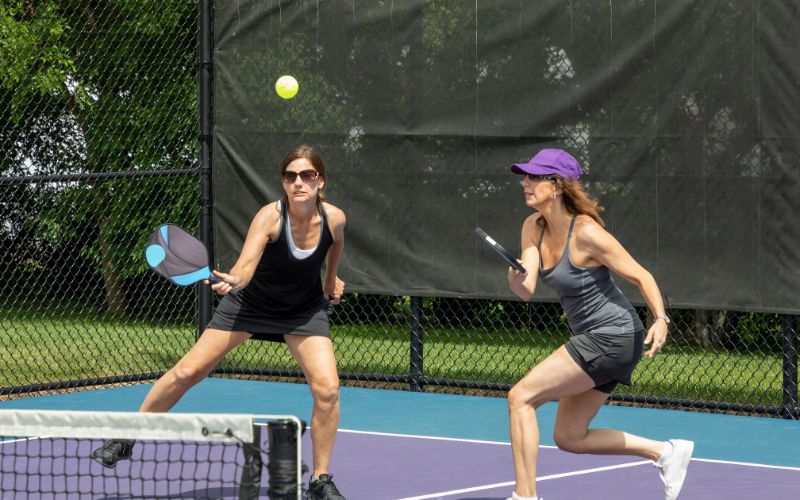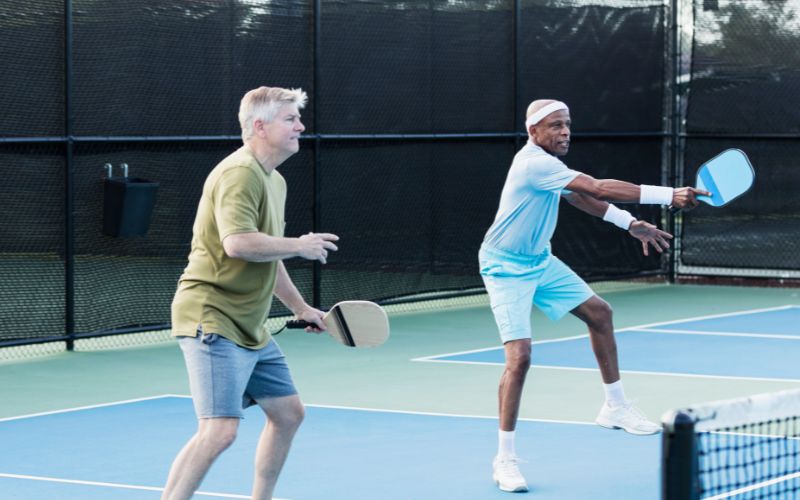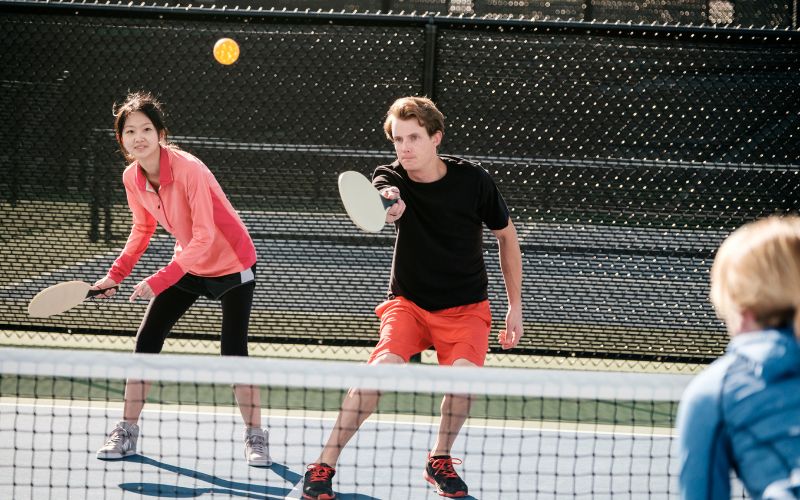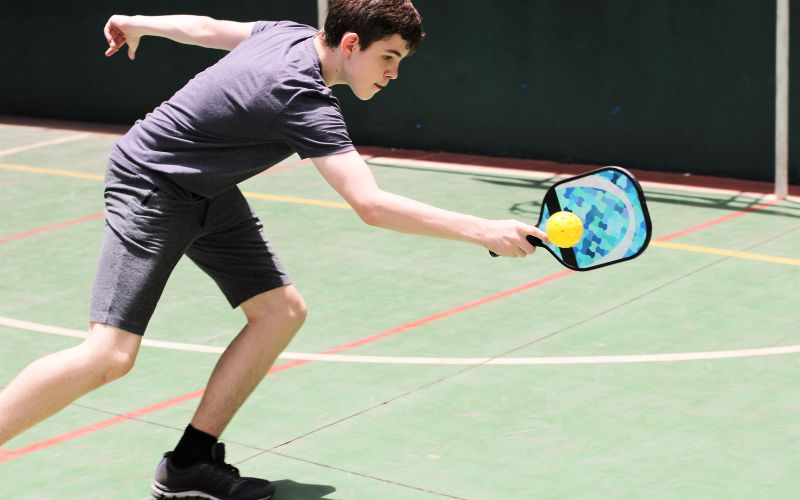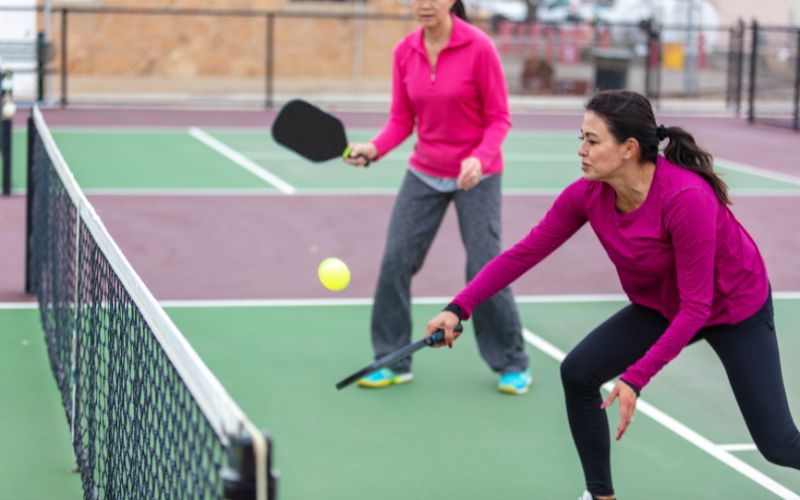Pickleball, the beloved sport that combines elements of tennis, badminton, and table tennis, has been gaining tremendous popularity in recent years. Whether you’re a seasoned player or just starting out, mastering the art of hitting a pickleball is essential for success on the court. In this comprehensive guide, we’ll explore how to hit a pickleball effectively, covering various techniques, strategies, and tips to elevate your game.
Understanding the Basics of Pickleball
Before delving into the intricacies of hitting a pickleball, it’s crucial to grasp the fundamental aspects of the game. Pickleball is typically played on a pickleball court, which resembles a miniature tennis court but with specific dimensions. Players use solid paddles made of wood or composite materials to hit a whiffle ball across the net. The objective is to outmaneuver opponents by strategically placing shots and ultimately scoring points.
The Ready Position: Foundation for Success
One of the key elements in how to hit a pickleball proficiently is assuming the correct ready position. Your stance should be balanced, with feet shoulder-width apart, knees slightly bent, and weight evenly distributed. Hold the paddle with a firm grip, positioning it in front of your body with the paddle face open, ready to react to incoming shots.
The Anatomy of a Pickleball Paddle
Understanding the components of a pickleball paddle is essential for maximizing performance on the court. The paddle face is the hitting surface, while the paddle head refers to the top portion of the paddle. Players can generate power and control through proper paddle manipulation, utilizing the entire body in each shot.
Mastering Pickleball Techniques
1. Perfecting the Forehand Drive
The forehand drive is a fundamental shot in pickleball, characterized by a forward swing motion executed with the dominant hand. To execute a successful forehand drive, position your body sideways to the net, shift your weight onto the front foot, and rotate your torso as you swing the paddle forward. Aim to make contact with the ball squarely, ensuring accuracy and power in your shot.
2. Unleashing the Backhand Shot
While the forehand drive tends to be more dominant, mastering the backhand shot is equally crucial for a well-rounded game. The key to a proficient backhand lies in maintaining proper body positioning and wrist action. Keep your non-dominant hand steady on the paddle grip, pivot your body slightly, and execute a fluid swing motion to make clean contact with the ball.
3. Exploring Advanced Shots: Drop Shots and Third Shot Drops
In addition to basic strokes, incorporating advanced shots such as drop shots and third shot drops can significantly enhance your gameplay. A drop shot involves delicately tapping the ball over the net, causing it to bounce low and close to the net, making it challenging for opponents to return. The third shot drop, a strategic maneuver used in doubles play, aims to initiate a rally by softly placing the ball into the opponent’s court, setting up for a favorable position.
4. Utilizing the Lob Shot for Tactical Advantage
Contrary to drop shots, the lob shot is employed to loft the ball high over the net, forcing opponents to retreat towards the baseline. Mastering the lob shot requires precise timing and control, as well as the ability to read your opponent’s positioning on the court. Use the lob shot strategically to break the rhythm of play and create opportunities for offensive maneuvers.
5. The Block Shot: Defense and Counterplay
When faced with aggressive shots from opponents, the block shot serves as a defensive mechanism to neutralize the pace and trajectory of the ball. Instead of swinging aggressively, angle the paddle slightly upward and meet the ball with a controlled blocking motion. The block shot allows players to redirect the ball with precision, buying time to regain positioning and launch a strategic counterattack.
6. Serving: Underhand Stroke Technique
In pickleball, serving differs from tennis, requiring an underhand stroke where you contact the ball below your waist level, swinging in a low to high motion. The goal is to engage all muscles in your body to provide ample power effortlessly. Start by stepping forward as you initiate the serve, with a closed or semi-open stance. Ensure your shoulders face sideways, finishing facing the net, and maintain a smooth, relaxed swing with a loose grip. Visualize hitting through three balls in a line to ensure the correct paddle trajectory.
7. Groundstrokes: Footwork and Swing Dynamics
Groundstrokes are crucial for playing from deeper in the court or returning serve. Focus on footwork by positioning your feet before swinging. Step back, to the side, or forward, ensuring the ball is slightly ahead of your body upon contact. Transfer weight forward onto the balls of your feet, keeping heels down to maximize energy transfer. Shorten backswing, focusing on striking the ball cleanly for fast and hard shots.
8. Volleys: Stable Paddle Face and Contact Point
Volleys are compact shots hit before the ball bounces, adaptable for soft or power play. Maintain a stable paddle face, slightly open, executing a pushing motion with the paddle. Whether forehand or backhand, contact the ball about one to two feet away from your body to avoid falling short or sending the ball too high or off to the side.
9. Drops: Precision and Speed Control
Drops are strategic shots arcing gently over the net to make opponents run. Ensure the apex of the ball is on your side of the net, reducing speed to achieve the desired descent. Practice to gauge the right force for your target area. Well-executed drop shots force opponents to hit up, ideal for transitioning to the net.
10. Dinks: Consistent Motion and Low Body Position
Dinks are softly-struck shots, primarily from the NVZ line, setting up attacks. Utilize a continental grip, starting with the paddle low to the ground, employing a pushing motion with a short backswing and follow-through. Maintain consistency for speed and direction control, adopting a low body position with bent knees for better visualization and control.
11. Offensive vs. Defensive Play: Strategic Awareness
Understanding offensive and defensive stages is crucial for shot selection. Focus on defense to stay in the game, maintaining a good ready position and avoiding high-risk shots. Defensive play aims to neutralize and regain control. Offensive play involves approaching the kitchen line, aiming to dominate the ground war and keep opponents on the defensive. Recognizing when to defend and how to defend effectively elevates your game to new heights.
In summary, mastering these basic shots and understanding strategic gameplay will empower beginners to navigate the pickleball court with confidence and skill. Practice diligently, focus on technique, and embrace the dynamics of offensive and defensive play to excel in the sport.
Strategies for Power and Precision
Generating Power Through Technique
Power in pickleball stems from a combination of proper technique and efficient paddle manipulation. To generate power, focus on engaging the entire body in your shots, from the legs and hips to the shoulders and arms. Channel kinetic energy through fluid motion, transferring momentum from the ground up to the paddle head, resulting in explosive shots that catch opponents off guard.
Emphasizing Control and Accuracy
While power is essential, control and accuracy are equally vital components of successful pickleball play. Concentrate on hitting the ball cleanly and consistently, aiming for specific target areas on the court to exploit opponent weaknesses. Develop a smooth follow-through motion to maintain control over the trajectory and spin of the ball, dictating the pace and tempo of the game.
Fine-Tuning Your Technique: Tips for Improvement
Improving your pickleball skills requires dedication, practice, and a willingness to refine your technique continually. Experiment with grip variations, paddle angles, and shot selection to discover what works best for your playing style. Focus on hitting the ball at waist level or slightly below to optimize power and accuracy, utilizing wrist action to impart spin and finesse to your shots.
Maximizing Efficiency on the Court
In pickleball, efficiency is paramount, especially when conserving energy over extended rallies and matches. Position yourself strategically on the court, anticipating opponent movements and adjusting your positioning accordingly. Maintain a light grip on the paddle to facilitate quick reflexes and swift paddle adjustments, enabling you to react to incoming shots with precision and agility.
Common Mistakes to Avoid
Overcommitting to Shots: Finding Balance
One common mistake among pickleball players is overcommitting to shots, particularly when attempting aggressive winners or risky maneuvers. Instead of swinging for the fences, focus on consistent shot placement and strategic court positioning. Exercise patience and discipline, waiting for the opportune moment to capitalize on openings and exploit opponent vulnerabilities.
Neglecting Defensive Strategies
While offense is essential, neglecting defensive strategies can leave players vulnerable to counterattacks and momentum shifts. Prioritize court coverage and defensive positioning, maintaining a balanced stance and readiness to react to incoming shots. Anticipate opponent intentions and adjust your positioning accordingly, utilizing a combination of blocks, lobs, and volleys to thwart offensive advances.
Lack of Adaptability and Versatility
In pickleball, adaptability and versatility are keys to success, allowing players to adjust to varying playing styles and court conditions. Avoid becoming too reliant on specific shots or strategies, instead embracing a diverse skill set that encompasses a wide range of strokes and techniques. Continuously seek opportunities for improvement, learning from both victories and defeats to evolve as a player.
Final Thoughts
Mastering how to hit a pickleball encompasses a blend of technical proficiency, strategic acumen, and mental fortitude. By honing fundamental skills, exploring advanced techniques, and cultivating a deep understanding of the game, players can elevate their performance and enjoy greater success on the court. With dedication, practice, and a passion for the sport, anyone can unlock their full potential and experience the thrill of pickleball at its finest.
Frequently Asked Questions (FAQs) about Hitting a Pickleball
What are the fundamental components of hitting a pickleball effectively?
To hit a pickleball effectively, it’s crucial to understand the basics of the game, assume the correct ready position, and grasp the anatomy of a pickleball paddle. These elements lay the foundation for mastering various techniques and strategies on the court.
What is the significance of the ready position in hitting a pickleball?
The ready position is essential for success in pickleball as it ensures balance, agility, and readiness to react to incoming shots. With feet shoulder-width apart, knees slightly bent, and a firm grip on the paddle, players can effectively anticipate and respond to gameplay dynamics.
How can beginners improve their forehand and backhand shots in pickleball?
Beginners can enhance their forehand and backhand shots by focusing on proper body positioning, wrist action, and swing dynamics. By practicing fluid motions and aiming for clean contact with the ball, players can develop accuracy, power, and consistency in their strokes.
What are some advanced shots in pickleball, and how can players incorporate them into their gameplay?
Advanced shots such as drop shots, third shot drops, lob shots, and volleys add depth and versatility to pickleball gameplay. Players can integrate these techniques by refining their timing, control, and strategic decision-making on the court.
What common mistakes should pickleball players avoid to improve their performance?
Common mistakes to avoid include overcommitting to shots, neglecting defensive strategies, and lacking adaptability and versatility. By maintaining patience, discipline, and a willingness to learn from both successes and failures, players can elevate their game and maximize their potential on the court.

